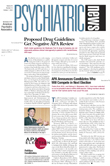Improving the effectiveness of depression treatment in primary care may be as simple as picking up the telephone to provide vital interaction and follow-up with patients initiating antidepressant therapy.
Integrating a structured cognitive-behavioral therapy (CBT), delivered over the phone, into a pharmacotherapy-based depression treatment plan may significantly improve not only patients' depression-scale scores and increase rates of response and remission, but may also improve patients' satisfaction with depression treatment, according to new research.
Gregory Simon, M.D., M.P.H., a psychiatrist at the Center for Health Studies at Group Health Cooperative (GHC) in Seattle, and colleagues conducted a randomized, controlled trial comparing usual primary care treatment for depression to usual care plus a telephone care-management program, and to the care-management program supplemented by phone-based CBT. Results of the study, funded by the National Institute of Mental Health, were reported in the August 25 Journal of the American Medical Association.
Simon's group followed 600 patients who were from seven primary care group practices and had received a prescription for antidepressant medication from a GHC doctor. GHC is a group health plan covering just over 500,00 patients in Washington state.
Each patient underwent a baseline assessment including the Hopkins Symptom Checklist Depression Scale (SCL) and the Patient Health Questionnaire (PHQ). Patients were then randomly assigned to one of three groups. The first group was followed under “usual care” and was not contacted again until the first planned outcome assessment. Patients assigned to the telephone care-management (TCM) intervention group were contacted by care managers—mental health professionals with a bachelor's or master's degree and at least one year of experience in depression assessment—within four weeks after receiving their antidepressant prescription.
Care managers made two additional phone contacts for each patient in the TCM group, occurring four and 12 weeks after the first phone call, and also mailed a personalized contact about 20 weeks later. Each contact included a brief structured assessment of depressive symptoms, antidepressant use, and adverse effects. Treating physicians received systematic reports including summary assessment information and computer-generated recommendations regarding medication adjustment. If a change in medication was made, the care manager worked to facilitate patient-physician communications. The care managers were also available for as-needed crisis intervention and referrals to mental health specialty care if warranted.
Each patient in TCM also received a detailed self-management workbook that emphasized behavioral activation, identifying and challenging negative thoughts, and developing long-term self-care plans. Care managers gave recommendations on workbook activities but no specific counseling.
For those patients assigned to the group receiving telephone care-management plus psychotherapy (TCM/CBT), in addition to following the same protocol as the TCM patients, TCM/CBT patients received a structured eight-session CBT program with 30- to 40-minute sessions over the phone every two to four weeks throughout the study. For this group, telephone counselors had master's degrees and at least one year of experience in outpatient psychotherapy of depression.
All participants were contacted for a blind telephone outcome assessment at six weeks, three months, and six months after randomization. Each patient completed a self-rated measure of global improvement and was administered the SCL. At the three- and six-month assessments, patients were also administered the PHQ and a rating of satisfaction with depression treatment.
At baseline, patients reported a moderate level of depressive symptoms, roughly two to four weeks after starting antidepressant therapy. Improvement in SCL depression scores was greatest in the TCM/CBT group, intermediate in the TCM group, and least in the usual-care group.
The TCM/CBT group showed statistically significant improvements in depression scores. The effectiveness of both interventions varied according to baseline severity, with no apparent effect in those with mild baseline SCL scores, and similar effectiveness between those with moderate to severe symptoms at baseline.
In addition, Simon's group found, patients assigned to TCM were significantly more likely to use antidepressants at an adequate dose for at least 90 days. The trend was the same for the TCM/CBT group; however, the result did not reach statistical significance.
“Telephone programs may sacrifice the richness of traditional in-person therapy,” Simon and his coauthors wrote, but they“ allowed us to engage patients who might not be reached by traditional in-person treatment.”
The success, the researchers proposed, may be tied to the fact that“ level of therapist activity differed significantly from the traditional office-based therapist's role,” in the significant number of outreach calls and mailings to patients who did not respond to phone calls.
“Such a public health approach—rather than a traditional clinical approach—may be necessary to actually provide empirically supported psychotherapy to the majority of depressed patients not now served.”
The catch is, Simon told Psychiatric News, “this type of treatment is not currently reimbursable. And as long as people are not going to be paid for it, they are not necessarily going to implement it. But the program certainly would be appropriate in large group health plans.
“It's not, of course,” he added, “the kind of thing most primary care doctors are going to implement in their own practices.”
JAMA 2004 292 935
